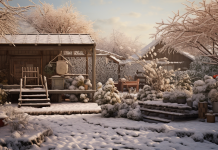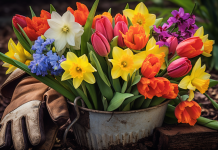In the never-ending pursuit of a thriving and vibrant garden follow our autumn cleanup tips for a healthy garden. Cleanup plays an important role in ensuring garden health and resilience.
This article offers a brief outline of the essential tasks, techniques, and insights.
Essential Tools for Autumn Garden Cleanup
To effectively tackle the autumn garden cleanup, it is essential to have a set of tools at your disposal. Proper garden tool maintenance is crucial for their longevity and functionality. Before starting the cleanup process, ensure that your tools are clean, sharp, and in good working condition. Regularly oiling the moving parts and sharpening the blades will ensure smooth operation.
Here are some essential tools you may need for your autumn garden cleanup:
The Basics
Rake: A sturdy garden rake is essential for gathering leaves, twigs, and other debris that have accumulated on your lawn and in your garden beds.
Leaf Blower: A leaf blower can be a time-saving tool for moving leaves and debris into piles for easier cleanup. It's particularly useful for larger properties.
Pruners and Shears: Pruning shears and hedge trimmers are necessary for cutting back overgrown or dead branches, shrubs, and perennials. This helps maintain the garden's shape and health.
Garden Gloves: Protect your hands from thorns, prickly plants, and sharp debris with a good pair of gardening gloves.
Wheelbarrow or Garden Cart: These are handy for transporting heavy loads of leaves, branches, and other garden waste to your compost pile or disposal area.
Shovel or Spade: These are useful for digging up and dividing perennials, transplanting plants, and turning soil in preparation for winter.
Optional
Mulching Mower: If you have a lot of leaves, consider using a mulching mower to chop them into smaller pieces and return them to your lawn as natural mulch.
Lawn Aerator: If your lawn has compacted soil, aerating it in the autumn can help improve air and water circulation, leading to healthier grass.
Weed Puller: Remove any lingering weeds to prevent them from taking over in the spring. A weed puller or weeder tool can make this task easier.
Garden Pruning Saw: For cutting larger branches or small trees, a pruning saw can be more effective than hand pruners.
Safety
Safety Gear: Depending on the tasks you're undertaking, safety gear such as safety glasses, ear protection, and knee pads may be necessary.
Garden Bag or Tarp: Use these to collect and transport debris. Bags with handles are convenient for carrying leaves and other materials.
Ties or Twine: Use garden ties or twine to secure plants, especially tall or floppy ones, to prevent wind damage during winter storms.
With these essential tools you'll be well-equipped to tackle the autumn garden cleanup and prepare for the upcoming season.
Clearing Away Fallen Leaves and Debris
Compost Bin or Pile: Collect organic materials such as leaves, small branches, and plant clippings for composting. A compost bin or designated pile is an eco-friendly way to recycle garden waste.
- Composting benefits: Instead of throwing away the fallen leaves and debris, consider starting a compost pile. Composting not only reduces waste but also provides nutrient-rich soil for your garden in the future.
- Using leaf blowers for efficient debris removal in the garden: Leaf blowers can be a time-saving tool for clearing large areas of fallen leaves. Choose a leaf blower with adjustable speed settings to control the airflow and prevent damage to delicate plants.
- Raking and bagging: For smaller gardens or areas with delicate plants, using a rake and bagging the leaves manually is a better option. This allows for a more precise cleanup without disturbing the surrounding plants.
- Mulching: Another option is to use a mulching mower to finely chop the fallen leaves and spread them back onto the garden beds. This provides a protective layer and adds organic matter to the soil.
Pruning and Trimming Plants for Winter
One important task for gardeners in the autumn season is to prune and trim plants in preparation for winter.
Our supporting article: Autumn Pruning Essentials for Healthy Trees and Shrubs may be of interest. Winter plant care is essential for ensuring the health and vitality of your garden. Proper pruning and trimming techniques to remove dead or diseased branches, promote healthy growth, and protect plants from harsh winter conditions.
Here are some winter pruning techniques that gardeners can follow:
| Technique | Description |
|---|---|
| Deadheading | Removing spent flowers to encourage new growth and prevent the plant from wasting energy on producing seeds. |
| Crown thinning | Removing select branches to improve airflow and reduce the risk of snow or ice damage. |
| Structural pruning | Shaping young trees by removing undesirable branches and promoting a strong framework. |
| Rejuvenation pruning | Cutting back older shrubs to stimulate new growth and rejuvenate the plant. |
| Pruning fruit trees | Removing dead or damaged branches, shaping the tree for better fruit production, and promoting airflow to prevent diseases. |
Preparing the Soil for Next Spring
Soil preparation is crucial for a successful spring garden. Test your soil to determine its pH level and nutrient content. Adding organic matter, such as compost or well-rotted manure, improves soil structure and fertility. Here are four key steps to preparing your soil for next spring:
- Test the soil: Conduct a soil test to determine its pH level and nutrient content. This will help you identify any deficiencies and adjust accordingly.
- Add organic matter: Incorporate compost or well-rotted manure into the soil to improve its structure, water retention, and nutrient availability.
- Mulch the garden beds: Apply a layer of organic mulch, such as straw or wood chips, to help retain moisture, suppress weeds, and enhance soil fertility as it breaks down over time.
- Avoid compacting the soil: Minimize foot traffic and heavy machinery on the garden beds to prevent soil compaction, which can hinder root growth and nutrient absorption.
Protecting Plants and Shrubs From Frost and Cold
Shielding plants and shrubs from frost and cold temperatures is beneficial for maintaining their health and vitality during the autumn / winter seasons.
One effective method is to insulate plants for winter by applying a layer of mulch around the base. This helps to regulate the temperature of the soil, limit the degree of freezing and potential damage to the roots.
Additionally, it is important to protect plants from pests that may seek shelter in the colder months. Inspect your plants regularly and remove any pests that you may find. See our: Winter Pest Control: Expert Tips for a Less Pest Garden
Conclusion
In conclusion, autumn cleanup is an investment in a healthy garden. Clearing away debris, pruning for winter, preparing the soil, and protecting plants from frost set the stage for a thriving garden come spring. These practices may help contribute to the longevity and vitality of your garden and ensure a successful gardening season next spring.
Please see our supporting article:
Autumn Pruning Essentials for Healthy Trees and Shrubs



